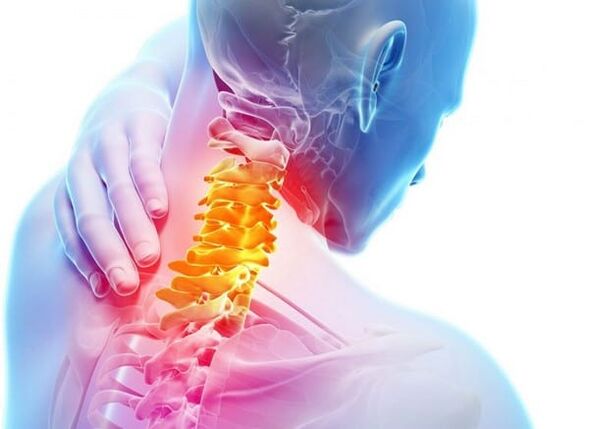
The symptoms of cervical osteochondrosis can appear at any age, but the risk increases after 25 years.The first treatment begins, more possibility to stop the disease on the bud and avoid unpleasant complications.
Symptoms of osteochondosis of the cervical column
The signs of the cervical column in the initial phase of the disease can be lubricated, manifested episodically and not immediately notify the patient.
Osteochondrosis-In more than deformation of the vertebrae of a spine associated with degenerative (destructive) processes that rejoice in it.
The reasons can be different:
- Constant physical overload, irregular elongation of the muscles, long living room in a static position (seated on the computer, guiding a car);
- Neck injuries;
- Improper nutrition with a predominance of fat, salty and acute foods;
- Alcohol and cigarette abuse;
- Metabolic and endocrine disorders.
At risk, people who have burdened heredity, overweight and patients with rheumatism.Sinealing, severe stress, can cause an exacerbation of the cervical osteocondrosis.
Under the influence of external or internal factors in the spine, the pathological processes associated with a change in the form and position of the vertebrae, in the improvement of the cartilage and in the formation of bone growths begin.
All this leads to pinches of blood vessels and nervous finals.Brain nutrition is disturbed, pain and discomfort appear.
The symptoms of cervical osteochondrosis include:
- Headache and dizziness;
- Weakness, prefabricated condition, fainting;
- A feeling of general malaise, weakness, constant tiredness;
- Neck pain, neck, shoulder belt, creak when turning the head.
At the same time, visual acuity can decrease, listen to worsening, patients complain of noise in the ears and "flies" before their eyes.The symptoms described are the result of innervation disorders.
A long -term violation of the blood supply to the brain causes migraines, vegetative vascular disorders, respiratory pathologies and cardiovascular system.
The vertebrae of the cervical region are highly mobility with small dimensions and the neck muscles are relatively weak.The cervical column is negatively influenced by static and high physical activity.
Degree of illness
There are 4 degrees of cervical osteochondosis.Each of them corresponds to its own symptoms, but in some cases a specialist cannot only make an accurate diagnosis.
- The deformation of the spine is at the beginning, in the cartilage and bone tissue the changes are not almost evident, the emerging symptoms are episodic.Patients associate pain and discomfort with overload, stress, physical effort;
- The shape and height of the intervertebral disc changes, its integrity can be violated.At this stage, the pain in the neck, the shoulder belt becomes constant.It can become insensitive, his head hurts.
- The intervertebral hernias, tightening the nerves and blood vessels, cause serious headache, weakness, dizziness, pre -Fabric and fainting conditions.The patient feels fatigue, pain in the back of the head, noise in the ears.
- The vertebrae are deformed, bone growth appear on them - osteophytes pinched the nerves.The vertebrae of the neighboring departments suffer, the usual movements are disturbed, their breadth is reduced, each movement is accompanied by severe pain in the neck, shoulder and clavicle.

Treatment of cervical osteochondosis
In men, cervical osteochondrosis is less common than women, it starts later, but the symptoms are more pronounced and the disease develops more quickly.In the first signs of the disease at home, it is necessary to start an accessible treatment:
- Daily neck gymnastics includes simple exercises that develop the spine and the muscle system that improve blood circulation (circular rotation of the neck, inclined behind, inclined back and forth);
- Alcohol and oil compresses, salt heating bearings (they cannot be used in the acute phase) will help relieve neck pain;
- Alleviating the symptoms of cervical osteochondrosis will help the use of drugs: spasmias, painkillers, anti -inflammatory drugs.
In the first signs of deformation degenerative processes in the cervical region, it is necessary to seek medical assistance.As a rule, a conservative treatment is prescribed:
- physiotherapy;
- Massage (necessarily - professional!);
- The intake of drugs that not only breed the symptoms of the disease, but also contributes to the restoration of the cartilage tissue - chondroprotectors in tablets or injections.
Cervical osteochondrosis is easier to warn than to cure.
Among the preventive measures are the refusal of harmful salsy and acute foods, respect for the work and rest regime, a balanced physical activity.















































